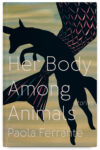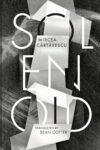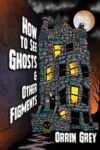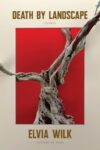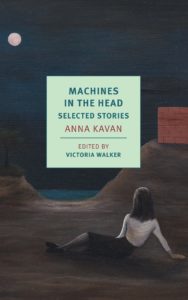
[New York Review Books; 2020]
Anna Kavan is a singular presence in a group that includes the likes of Eve Babitz, Ingeborg Bachmann, and Ann Quin, writers whose work has been recently reissued to both acclaim and newfound followings. But Kavan’s writing feels both of the present and uniquely unparalleled. Her work is, by some odd logic, contemporary — which is to say, her writing is one that matches the hallucinatory chaos of our present. Her stories feel prescient today; they capture the madness and degradation of isolation and living in a ravaged world, sentiments I can’t help but feel have also been evoked during our self-quarantined present.
Collected in Machines In The Head, under an arresting and apocalyptic cover featuring Gertrude Abercrombie’s Reverie (1947), are stories that span thirty years of Kavan’s career and which consequently evidence the transformation of Kavan’s style and writing concerns as they reflected what was both occurring in her personal life (institutionalization, war work, drug abuse), and what was occurring more broadly — politically. The selections previously appeared in Asylum Piece (1940), I Am Lazarus (1945), A Bright Green Field (1958), Julia and the Bazooka (1970), and also include a previously unpublished story, “Starting a Career.” And yet, Kavan is best known for her acclaimed dystopian novel Ice (1967), which is somewhat of an injustice. Her short stories, the best of which are included in this volume, showcase the vastness of both her style and subject matter.
In this edition’s foreword, Victoria Walker — likely the preeminent authority on Anna Kavan (Walker is at work on the first critical study of Kavan) — rightly acknowledges how Kavan is compared to writers of such varying styles and preoccupations as Franz Kafka, Jean Rhys, Jane Bowles, Leonora Carrington, H.P. Lovecraft, Ann Quin, and Muriel Spark, among many others. Comparing Kavan to both Rhys and Lovecraft is not meant to be contradictory. Rather, this comparison evinces Kavan’s incredible talent and verisimilitude: she could do it all. And do it well, at that. Walker’s foreword is concise and necessary, an essential primer to understanding Kavan and the works in the volume, and one which hints at the mix of gothic, surrealist, and experimental fiction that will follow in the collection.
Despite the comparisons acknowledged by Walker, Kavan is still best known for being an “experimental writer” — though there is something isolating about such a title. The presumption is that Kavan is a niche writer (which, she is — but does she have to be?). Kavan’s style certainly is not mainstream, but calling her writing experimental seems like a scapegoat, a way to further divorce her from the larger mainstream conversation. Which is to say, this is a process of doing to Kavan what she for so long feared in her daily existence: alienation.
Kavan felt like an outsider for perhaps her entire life. It is no surprise then that her most notable preoccupations within her writing were isolation, loneliness, and paranoia. But she was not ignorant to what made her feel such a way. Despite her experimental stylistic choices, Kavan could also be an incredibly lucid writer, one who was able to examine how she arrived to feeling so alienated. Kavan is a political writer, too: it was because of the social and political structures — these well-oiled, invincible machines — that Kavan faced so many roadblocks in her life, including institutionalization. She was fearless and unafraid of calling out the cruelties of this world, many of which were a result of the misogynist trappings of her government and society at large, which all her stories tackle to some degree.
Anna Kavan’s personal life has been a bit shrouded in mystery, which adds to Kavan’s appeal as an enigmatic literary figure. But Walker delves into Kavan’s biography, details that feel necessary to the volume. Anna Kavan was born Helen Emily Woods in 1901 in Cannes to wealthy British parents. At nineteen, she married Donald Ferguson and became Helen Ferguson; the marriage only lasted a few years. She then took up with British artist Stuart Edmonds and began writing novels for a mainstream audience using her married name Helen Ferguson. It wasn’t until after she was institutionalized for a nervous breakdown that she adopted the name Anna Kavan, a name she had previously given a character in her novels. With the new name, she also adopted the literary style she is now known for. “Her characters became nameless and enigmatic, her plots became scanty and her themes inclined towards darkness, fantasy, madness and dystopia,” Walker writes of the shift.
The stories included in this collection are brief, nightmarish, and condensed with paranoia and unavoidable doom. Kavan’s work is disorienting. Her writing gets under your skin. Her characters are both delusional and easy to root for; you want them to be victorious in the war against their oppressors. On the surface, the stories are most concerned with institutionalization and imprisonment, the effects of the Second World War, and drug abuse. But, once tossed in the Kavan grinder, the stories all deal in some way with broader themes within the specificity of Kavan’s experience: alienation, loneliness, the cruelty of the world, and oppressive social and bureaucratic structures. In a notably cogent moment, one of Kavan’s characters wonders, “How did all this atrocious cruelty ever get into the world, that’s what I often wonder. No one created it, no one invoked it, and no saint, no genius, no dictator, no millionaire, no, not God’s son himself, is able to drive it out.”
In “The Summons,” a standout from Asylum Piece, the narrator meets her friend R for dinner. R, like the narrator, is a writer, but one with newfound success, greater than the narrator’s own self-proclaimed failures. During their dinner, the narrator receives a summons, and is asked to leave by certain government officials. Eventually, she concedes and leaves with the two men. Kavan writes, “I began to wonder, as I have wondered ever since, whether the good opinion of anybody in the whole world is worth all that I have had to suffer and must still go on suffering — for how long; oh, for how long?”
In a later story, “The End In Sight,” a woman receives official notification of her sentencing (it’s never made clear exactly what the sentencing is) in the mail. “What is the correct behavior for a condemned person?” she wonders. “I watch the hours pass without bringing any reprieve. ‘Isn’t anyone going to do anything, then?’ I want to cry out. ‘Isn’t anything going to happen to save me?’” Then, in a moment of clarity, the woman in the story, and in a way Kavan herself, come to terms with the situation:
Possibly after all he is not my personal enemy but a sort of projection of myself, an identification of myself with the cruelty and destructiveness of the world. On a planet where there is so much natural conflict may there not very well exist in certain individuals an overwhelming affinity with frustration and death? And may this not result in an actual materialization, a sort of eidolon moving about the world?
This personal enemy she refers to, the person out to get her, becomes an enigmatic figure that recurs in the stories from Asylum Piece. “There is literally not a soul whom I can trust,” she writes.
The narrator in “Ice Storm” flees New York City to Connecticut in order to make an important life decision, unable to do so in New York where she “could not concentrate on anything at all.” In Connecticut, a severe ice storm follows, turning her surroundings into a strange, fantastic, frightening scape. “The trees were lovely and frightening to look at. I tried not to feel afraid of the trees. Dear God, let me not start being afraid of things in the natural world. It’s only the human world that is truly fearful.” And then: “They were fantastic-looking shapes. Fantastic and lonely.” “Ice Storm” includes many themes that Kavan would explore more thoroughly in her novel Ice, like female oppression and inclement weather. The story showcases Kavan’s fixation on her surroundings — all her stories provide incredible renderings of their setting and atmosphere, which are often turbulent and correspond to the internal turmoil within her characters.
In the selections included from Julia and the Bazooka, Kavan most overtly confronts the presence of heroin in her life. In the titular story, a tennis professional introduces Julia to heroin in order to improve her game. The tennis professional calls the syringe a bazooka, something Julia will implement for the rest of her life. Regarding Julia, Kavan writes that “nothing can frighten her while she has the syringe,” her syringe is “as essential to her as insulin to a diabetic,” and “she hardly remembers how sad and lonely she used to feel before she had the syringe.” In a moment of strange (autobiographic?) clarity, Kavan writes that Julia’s “personality has been damaged by no love in childhood so that she can’t make contact with people or feel at home in the world.”
In “The Old Address,” a woman is released from some form of institutionalization. She is given back her syringe along with her other belongings. The harshness of the outside world is shocking to her: “This isn’t the world I know. . . It all looks delirious, ominous, mad.” Kavan continues: “I search in vain for a human face. Only hordes of masks, dummies, zombies go charging past, blindly, heads down. . . Cold enemy eyes, arrow eyes pierce me with poison-tipped suspicion, as if they know where I’ve come from.” The narrator then imagines being hit by a car only to find that she has been “transformed into an inexhaustible fountain, spouting blood like a whale.” So much blood spews out that she drowns all the nearby children (“There’s no end to my blood supply. It’s been turned on full at the main”). But she revels in this, a kind of revenge for being persecuted her whole life. Towards the end of the story, Kavan writes:
The terror of life imprisonment stupefies me; I feel it inside me like an intolerable pain. I only know that I must escape from this hell of hallucination and horror. I can’t endure my atrocious prison a moment longer. There’s only one way of escape that I’ve ever discovered, and needless to say I haven’t forgotten that.
Kavan was a writer who enjoyed revisiting many of the same themes throughout her work. The theme of imprisonment, for example, isn’t isolated to Asylum Piece, but continues to be explored in later stories. Kavan’s women are always isolated and imprisoned in the world, whether it is a near-apocalyptic weather-torn world in “Ice Storm” or the fog-filled atmospheric trappings of “Going Up In The World,” where the protagonist is imprisoned by both her own poverty and the ungenerosity of others, and by the extreme cold and fog of her literal surroundings.
Again, this is not unlike the present. As I write this, we live trapped in isolation, with ungenerous governments and a literal pandemic wreaking havoc, keeping us indoors, where our own isolated narratives mirror Kavan’s moods: frazzled, desperate, with even more inescapable doom on the horizon. In a particularly lucid moment, Kavan writes, “There’s no justice for people like us in the world: all that we can do is suffer as bravely as possible and put our oppressors to shame.” Because of such fragments that deeply resonate with the state of our current socio-political and epidemiological climate, Kavan becomes an obvious choice for a reappraisal of her work. Her writing speaks to a populace much like ours and affirms that much is still to come. What that is, who knows. But if you want to feel seen and heard, Kavan is a good place to start. Cuddle with Machines In The Head and watch as the apocalypse continues to unfold.
Josh Vigil is a writer living in New York.
This post may contain affiliate links.




